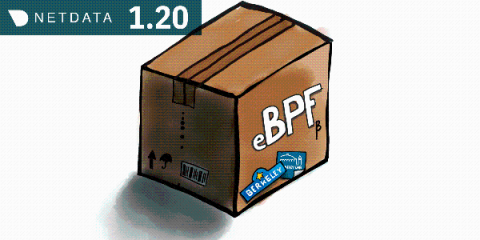Operations | Monitoring | ITSM | DevOps | Cloud
DevOps
The latest News and Information on DevOps, CI/CD, Automation and related technologies.
Release 1.20: Kernel monitoring 'superpowers' and infrastructure-wide labels
In Netdata’s first major release of 2020, we’re introducing two new features on the opposite ends of the monitoring spectrum. On one hand, we’re releasing an eBPF collector, which lets you collect, monitor, and visualize incredibly precise metrics straight from the Linux kernel. On the other, we added the ability to label agents to help you organize entire infrastructures and see every important piece of information about streaming nodes in one place.
Linux eBPF monitoring with Netdata
Your application isn’t finished when you’ve closed the last if block and you lined up all the brackets. There’s a whole other world of testing, debugging, and optimization that you haven’t even touched yet. To help you more safely step into that complex phase of making your application even better, we’ve just released a brand-new eBPF collector in v1.20 of Netdata.
Windows 10 Migration - Cause and Effects
Azure Functions Live - February 2020
Dell Technologies SVP, Jim Donovan and Virtana CEO Philippe Vincent
Image scanning for CircleCI
In this blog post, we are going to cover how to perform container image scanning for CircleCI using Sysdig Secure. Image scanning allows DevOps teams to detect and resolve issues, like known vulnerabilities and incorrect configurations, directly in their CI/CD pipelines. Using Sysdig Secure, you can enforce image policies to block vulnerabilities before they reach production environments and fix them faster while the developer still has the context.
Improving Kubernetes Clusters' Efficiency with Log Management
Log management plays an important role in helping to debug Kubernetes clusters, improve their efficiency, and monitor them for any suspicious activity. Kubernetes is an open-source cluster management software designed for the deployment, scaling, and operations of containerized applications.
Serverless is more than AWS Lambda
Too often serverless is equated with just AWS Lambda. Yes, it’s true: Amazon Web Services (AWS) helped to pioneer what is commonly referred to as serverless today with AWS Lambda, which was first announced back in 2015. But in 2020, it’s important for enterprises to understand that the serverless landscape is much bigger with more opportunities. Serverless is sometimes (narrowly) defined as just being about functions-as-a-service, but that’s a very limited viewpoint.
The Lifecycle of a Service
Services are the backbone of our systems. Whether they’re functional microservices or logical components of a traditional application, they are the pieces that make up our businesses. We can’t do the computer thing without services. But who’s responsible for owning a service in your company or organization? The cast of characters involved in the lifecycle of a service is more than just software engineers.











